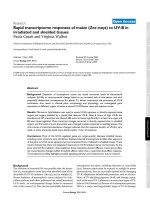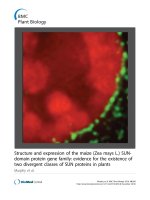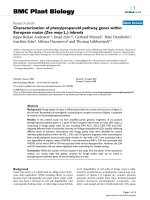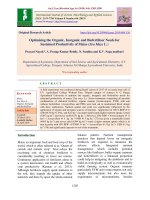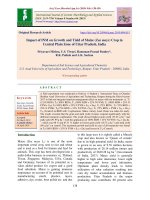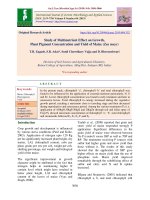Effect of different nutrient management practices and zinc fertilization on various growth and development stages of maize (Zea mays L.) under dryland condition
Bạn đang xem bản rút gọn của tài liệu. Xem và tải ngay bản đầy đủ của tài liệu tại đây (225.88 KB, 9 trang )
Int.J.Curr.Microbiol.App.Sci (2019) 8(6): 81-89
International Journal of Current Microbiology and Applied Sciences
ISSN: 2319-7706 Volume 8 Number 06 (2019)
Journal homepage:
Original Research Article
/>
Effect of Different Nutrient Management Practices and Zinc Fertilization
on Various Growth and Development Stages of Maize (Zea mays L.) under
Dryland Condition
Anjalee Panda, V.M. Bhale, Subhradip Bhattacharjee* and S.R. Kadam
Dr. Panjabrao Deshmukh Krishi Vidhyapeeth, Akola (M.S), India
*Corresponding author
ABSTRACT
Keywords
Zinc, Nutrient
management,
Maize, RDF
Article Info
Accepted:
04 May 2019
Available Online:
10 June 2019
Field studies were carried out during the growing season 2015-16 at Research Farm,
Department of Agronomy, Dr. Panjabrao Deshmukh Krishi Vidyapeeth, Akola
(Maharashtra) to study “Effect of different nutrient management practices and zinc
fertilization on various growth and development stages of maize (Zea mays L) under
dryland condition”. The treatments were laid out in a randomized block design (FRBD)
with three replications. The experimental results indicate that application of RDF 125%
along with ZnSO4 @ 20 kg ha-1 procured the best result in maximum growth parameters
and sometime found to be at par with the application of RDF 125% along with ZnSO 4 40
kg ha-1.
contributing 3 percent of the global
production (Anonymous, 2014). But when it
comes to productivity; the state of
Maharashtra has far low productivity (4.34 t
ha-1) than the global average. Being versatile
crop maize can be grown virtually
everywhere hence it is a good choice for
dryland area.
Introduction
Maize (Zea mays L.), is also known as corn,
Makka or Makki which belongs to family
Poaceae is the world’s 3rd most important
cereal crop after rice and wheat. Maize (Zea
mays L.) is produced largely worldwide than
any other cereal grain and it has a pivotal role
in increasing the income of both substance
and commercial farmers. India ranks fifth in
the area and third in production and
productivity among cereal crops (Rao et
al.2014). In India, maize is being cultivated in
an area of 8.78 million ha with a production
of 24 million t and average productivity of 2.5
t ha-1 the fifth largest producer in the world
In developing countries of Asia and Africa;
maize is providing much-needed nutrition to
otherwise hungry people. It is estimated that
several million people in developing countries
derive their protein and calorie (11.1 g and
342 kcal day-1) requirement from maize
(Gopalan et al., 1999) thus, maize grain
81
Int.J.Curr.Microbiol.App.Sci (2019) 8(6): 81-89
accounts for about 15 to 56 percent of the
total daily diet of people in 25 developing
countries.
m. Sowing of maize was taken on 23-062015. The field was irrigated immediately
after sowing for assured seed germination.
Seeds were dibbled at 3-5 cm depth @ two
seeds per hill. Sowing was done at the spacing
of 60 cm between rows and 20 cm with in
rows with a seed rate of 20 kg ha-1. Maize
variety “PKV Shatak” was selected as a test
variety with a duration of 85-95 days and
yield potential of 55-60 q ha-1. The
experiment had 8 treatments viz., T1- RDF
100 %, T2-RDF 125%, T3- RDF 75% + FYM
5 ha-1, T4- RDF 100% + ZnSO4 20 kg ha -1,
T5- RDF 100% + ZnSO4 40 kg ha-1, T6- RDF
125% + ZnSO4 20 kg ha-1, T7- RDF 125% +
ZnSO4 40 kg ha-1 and T8- RDF 100%+ Seed
priming with ZnSO4 1% w/v. The land
preparation was similar for all the treatments.
Eight plants were selected in the early stages
from each plot at random order. Each plant
marked with a small plastic white colored ring
and with wooden peg nearby for demarcation.
The same eight plants were observed at
various stages of crop growth up to the
harvesting stage for biometric observations.
These eight plants were harvested separately
for post-harvest observations.
Maize is capable of producing very high
amount of biomass and yield but with the
only condition that it requires a plentiful
supply of mineral nutrition. To prevent the
soil from getting exhausted especially in
dryland condition; it is very much essential to
maintain regular and balanced fertilizer
application. When it comes to fertilizer
application; micronutrients especially zinc has
never been considered seriously due to the
uncertainty of water and economically weaker
condition of the farmer. Physiologically
maize is very sensitive to zinc nutrition and
its growth and development are often
ostracized due to its deficiency. Indian soi, in
general, is deficient in zinc and requires
frequent zinc fertilization. Due to all these
facts stated above; it was necessary to conduct
an experiment in dryland vertisols of
Maharashtra to evaluate the effect of zinc
fertilization on growth and development of
maize hence the investigation entitled “Effect
of various nutrient management practices and
enriched zinc fertilization on various growth
and development stages of maize (Zea mays
L.) under dryland condition” was carried out.
Results and Discussion
The results obtained from the present
investigation have been presented under the
following heading
Materials and Methods
The experiment was carried out in the plot
No. 66 at Research Farm, Department of
Agronomy, Dr. Panjabrao Deshmukh Krishi
Vidyapeeth, Akola, Maharashtra during
Kharif season of 2015- 2016. The topography
of soil was fairly leveled with 2 percent grade,
clayey medium dark vertisols in nature and
moderately alkaline (pH 8.6). The organic
carbon of the soil was 0.51 g kg-1. The
chemical analysis of soil indicated various
available mineral nutrient contents as given in
Table 1. The experiment was arranged in a
randomized block design with three
replications, and the plot size was 4.8 m x 6
Growth characters
Plant height (cm)
Data derived from the experiment showed
that the zinc application had a significant
effect on the plant height of maize during 40
DAS and 60 DAS. The comparison of
treatment means revealed that zinc application
40 kg ha-1 along with increased does of
fertilizer (T7) consistently maintained
significantly tallest plant except 60 and 80
DAS. At grand growth stage (60 DAS) the
82
Int.J.Curr.Microbiol.App.Sci (2019) 8(6): 81-89
maximum plant height (180.2 cm) was
noticed with addition of zinc 20 kg ha-1 along
with increased fertilizer dose (T6) which was
comparable with addition of 20 kg ZnSO4
along with RDF as well as addition of 40 kg
ZnSO4 with 125% RDF and 100% RDF (T4,
T7 and T5). The recommended dose of
fertilizer produced shorter plants compared to
the rest of the treatments. Seed priming with
ZnSO4 improved plant height marginally.
More or less similar results were observed at
the stage of 40 DAS. Increase in plant height
with the addition of ZnSO4 either 20/40 kg
ha-1 in additions to the recommended fertilizer
dose increase in plant height may be due to
the availability of more nitrogen and
internodal distance due to zinc application.
These results were matching with the findings
of Mohseni and Haddadi (2014) (Table 2).
which confirms the increased no. of leaves at
125 % RDF (T2). More or less similar
observations were noticed at 80 DAS. At 60
DAS, maximum production of leaves was
observed with 100% RDF + 40 kg ZnSO4
which was at par with the application of 20
and 40 kg ha-1 of ZnSO4 along with 125%
RDF (T6 and T7). Nutrient management did
not show any significant variation in the
production of functional leaves at harvest.
Increased number of leaves with the
application of zinc maybe du to increased
mobility of nitrogen. Seed priming with
ZnSO4 along with RDF increased the number
of leaves marginally but not reached to the
level of significance which is different than
what has been observed by Fageria et al.,
(2006).
Leaf area plant-1 (dm2)
Functional leaves plant-1
Leaf area estimate is an important parameter
in understanding photosynthesis, light
interception, water and nutrient use, crop
growth and yield. The experiment indicated
that the leaf area increased progressively
during the vegetative stage and reached tothe
maximum during physiological maturity (80
DAS), thereafter it declined sharply towards
harvest maturity due to leaf fall owing to their
senescence. Experimental data revealed that
zinc application had a significant effect on
leaf area per plant across the crop growing
period.
Functional leaves are the important parameter
in understanding photosynthesis, light
interception, water and nutrient use, crop
growth and yield. It was observed that the
periodic number of functional leaves
increased progressively up to physiological
maturity but the magnitude of increase was
more than double from 60 to 80 DAS,
irrespective of the treatments. Results derived
from the experiment indicated that the zinc
application had a significant effect on the
number of functional leaves of maize during
the entire growth of plant except at 20 DAS
and at harvest.
At 20 DAS, maximum leaf area (0.0178 dm2)
was observed at RDF125% along with
ZnSO4@ 40 kg ha-1 (T7) which was at par
with application of ZnSO4@ 20 kg ha-1 along
with 125% RDF and with application of 40 kg
ha-1 of ZnSO4 along with 100% RDF (T6 and
T5) and found significantly superior than
alone 100% recommended dose of fertilizer.
More or less similar results were observed at
60 DAS.
At 40 DAS, application of ZnSO4@ 20 kg
At 20 DAS, various nutrient management
practices did not cause any significant
variation in a number of functional leaves. At
40 DAS application of ZnSO4@40 kg ha-1
(T7) was responsible for producing a
maximum number of leaves which was
comparable with 20 kg ZnSO4 along with
125% RDF & 100% RDF as well as with
increased RDF (T6, T4 and T2). Being heavy
feeder, maize responded to high fertility
83
Int.J.Curr.Microbiol.App.Sci (2019) 8(6): 81-89
ha-1 along with increased RDF (T6) was
responsible for producing maximum leaf area
which was at par with 40 kg ZnSO4 along
with increased fertilizer dose, 40 kg ZnSO4 +
100% RDF (T7 and T5) and significantly
superior over rest of the treatments. Being
heavy feeder crop, maize responded to high
fertility which confirms the increase leaf area
at 125 % RDF (T2). Seed priming with 1%
ZnSO4
along
with
RDF
produced
significantly more leaf area. More or less
similar observations were noticed at 80 DAS
and at harvest. Increased leaf area with the
application of zinc may be due to the increase
in leaf expansion (length and breadth), high
rate of cell division and cell enlargement,
rapid growth and there by improved quality of
vegetative growth. Reduction in RDF resulted
in a reduction of leaf area. This indicates that
the nutrient requirement could not be
compensated through FYM.
similar results were observed at 60 DAS. At
40 DAS, application of ZnSO4@ 20 kg ha1
along with increased RDF (T6) was
responsible for producing maximum leaf area
index, which was at par with 40 kg ZnSO4
along with increased fertilizer dose and with
100% RDF (T7 and T5) and found
significantly superior over rest of the
treatments
Being heavy feeder, maize responded to high
fertility, which confirms the increase in leaf
area index at 125% RDF (T2). Seed priming
with 1%ZnSO4 along with RDF produced
significantly more leaf area index. More or
less similar observations were noticed at 80
DAS and at harvest. Reduction in fertilizer
dose resulted in less leaf area index as the
nutrients could not be compensated by FYM.
Increase in leaf area index by zinc application
might be due to an increase in tryptophan
amino acid and indole acetic acid hormone,
which are two main factors of leaf area
expansion in maize crop. These findings were
earlier confirmed by Seifi Nadergholi et al.,
(2011).
Leaf area index
Leaf area index (LAI) is a measure of
leafiness per unit ground area and denotes the
extent of the photosynthetic machinery. It is
the most important indicator of the size of the
assimilatory system in maize to maximize
harvest of the incident solar radiation. The
experimental data indicated that there was a
considerable increase in leaf area index from
20 DAS up to 80 DAS to a maximum extent
of 5.45 then it showed declining trend at
harvest due to increasing aging of leaves,
shading, and competition between plants for
light and other resources. At 20 DAS,
maximum leaf area index (0.148) was
observed at RDF125 % along with ZnSO440
kg ha-1(T7) which was comparable with the
application of ZnSO4 40 kg ha-1 along with
100% RDF, application of 20 kg ha-1 of
ZnSO4 + 125% RDF, application of ZnSO4 20
kg ha-1 + 100% RDF (T5, T6 and T4) and
found significantly superior than alone 100%
recommended dose of fertilizer. More or less
Dry matter accumulation(g plant-1)
The study revealed that there was a gradual
increase in dry matter production of the crop
from knee height stage up to maturity. Results
showed that the dry matter accumulation
increased from a mean of 5.28 g plant-1 at 20
DAS up to 129.14 g plant-1 at harvest. A
gradual increase in dry matter accumulation
was observed at 40, 60, 80 DAS up to harvest.
At 20 DAS, maximum dry matter
accumulation (5.92 g plant-1) was observed
with the application of RDF 125% along with
ZnSO4 @ 20 kg ha-1 (T6) which was at par
with application of RDF 125% along with
ZnSO4 40 kg ha-1(T7), application of RDF
100% along with ZnSO4@ 40 kg ha-1 (T5) and
was significantly superior over the rest of the
treatments. Seed priming was found effective
84
Int.J.Curr.Microbiol.App.Sci (2019) 8(6): 81-89
to increase dry matter.
ultimately increased the dry matter
accumulation. These findings are in
conformity with those of Pokharel et al.,
(2009), Tetarwal et al., (2011) and Ravi et al.,
(2012).
At 40 DAS application of ZnSO4 20 kg ha-1
along with 125% RDF produce maximum dry
matter accumulation, which was comparable
with 40 kg ZnSO4along with 125% & 100%
RDF as well as with 20 kg zinc with 100%
RDF, and found significantly superior over
rest of the treatments. Reduction in dry matter
was observed with the reduced fertilizer dose.
Integration of nutrient through FYM could
not compensate for the dry matter
accumulation compared to RDF indicating no
beneficial effect of it on the growth of the
crop. Seed priming with ZnSO4 1% was
found beneficial to increase the dry matter of
maize. This trend was noticed at subsequent
growth stages of maize. Higher dry matter
production with the application of zinc could
be attributed to enhanced plant height, leaf
area index and photosynthates accumulation,
thereby improving the plant vigor due to the
source-sink relationship. Addition of zinc
along with RDF may be responsible for the
availability of nitrogen which reflected into
increased
growth
parameters,
which
Development characters
Days of 50% tasseling and 50% silking
The experimental data indicated that the
maize requires 45 days for 50% flowering and
51 days for silking. Across the treatment, it
was observed that the application of zinc
delayed the 50 % flowering and 50% silking.
In general, it was noticed that reduced
fertilizer dose reduced the days required for
50% flowering and silking by 2- 3 days. As
the levels of zinc increased, 50% flowering
was delayed. The abundant supply of
fertilizers to the crop will promote vegetative
growth form maize, there by delaying
flowering compared to the crop supplied with
less or without fertilizers which attains
flowering earlier (Table 3).
Table.1 Various available mineral nutrient content in the soil
Mineral Nutrient
Nitrogen
Concentration in soil
205.3 kg ha-1
Phosphorus
16.88 kg ha-1
Potassium
367.22kg ha-1
Zinc
0.59 mg kg-1
85
Procedure used in the analysis
Alkaline permagnate method
(Subbiah and Asija,1956)
Olsen’s method (Olsen et al.,
1954)
Neutral normal ammonium acetate
using Flame Photometer.
(Jackson, 1973)
Atomic absorption
Spectrophotometer (Lindsay and
Norvell, 1978)
Int.J.Curr.Microbiol.App.Sci (2019) 8(6): 81-89
Table.2 Plant height (cm), number of functional leaves plant-1 and dry matter accumulation (g plant-1) of maize as influenced by
various nutrient management practices and zinc application
Growth characters
No. of functional leaves plant-1
Plant height (cm)
Day after sowing
20
40
60
AH*
80
Day after sowing
20
40
60
Dry matter accumulation (g plant-1)
AH*
80
Day after sowing
AH*
20
40
60
80
T1 (RDF 100%)
13.56
46.06
153.13
177.00
182.53
6.10
7.00
7.20
12.56
9.93
4.65
25.40
53.90
85.00
110.86
T2(RDF 125%)
16.03
52.66
173.03
184.06
189.60
6.86
7.80
7.53
13.46
12.20
4.95
27.96
54.73
87.33
117.50
T3(RDF 75%+FYM 5 t ha-1)
14.5
44.33
159.16
165.16
170.93
6.80
7.23
7.33
12.10
10.73
4.39
22.80
44.13
71.50
102.76
T4(RDF100%+ZnSO4 20kg ha-1)
13.23
55.83
179.00
188.50
191.93
7.33
8.10
8.03
15.80
11.46
5.29
30.26
57.00
94.33
137.80
T5(RDF100%+ZnSO4 40 kg ha-1)
15.00
61.33
170.50
178.20
185.93
6.46
7.76
8.53
16.46
13.06
5.89
29.00
53.16
93.66
140.00
T6(RDF125%+ZnSO4 20kg ha-1)
15.63
65.66
180.20
185.50
191.33
6.60
8.26
8.26
15.73
12.46
5.92
31.16
61.56
103.33
144.00
T7(RDF125%+ZnSO4 40kg ha-1)
16.13
66.33
177.53
182.60
193.13
6.86
8.43
8.36
16.66
12.46
5.89
30.80
59.50
102.00
147.37
T8(RDF100%+seed priming
14.10
53.73
159.66
176.06
182.33
6.40
7.80
7.70
15.90
12.26
5.29
28.00
58.40
99.06
132.86
SE(m) ±
0.74
2.10
3.51
6.23
6.44
0.23
0.21
0.15
0.34
1.41
0.18
0.80
1.06
1.42
5.36
CD (P= 0.05)
NS
6.37
10.64
NS
NS
NS
0.64
0.46
1.04
NS
0.54
2.43
3.24
4.31
16.27
GM
14.77
55.75
169.02
179.64
185.97
6.67
7.80
7.87
14.84
12.1
5.28
28.53
55.3
92.02
129.14
WithZnSO4 1%)
(AH*- At harvest stage)
86
Int.J.Curr.Microbiol.App.Sci (2019) 8(6): 81-89
Table.3 Leaf area (dm2) plant-1, Leaf Area Index and developmental stages of maize as influenced by various nutrient management
practices and zinc application
Growth characters
Leaf area (dm2) plant-1
20
Day after sowing
40
60
Leaf Area Index
AH*
80
20
Day after sowing
40
60
AH*
80
Developmental stage
(in days)
Days to
Days to
50%
50%
tasseling
silking.
45
51
T1 (RDF 100%)
0.0118
0.0824
0.3613
0.6109
0.3026
0.09
0.68
3.00
5.08
2.50
T2(RDF 125%)
0.0141
0.0870
0.3804
0.6210
0.3458
0.11
0.72
3.16
5.17
2.88
45
50
T3(RDF 75%+FYM 5 t ha-1)
0.0101
0.0795
0.3481
0.5853
0.2847
0.08
0.66
2.89
4.87
2.36
44
50
T4(RDF100%+ZnSO4 20kg ha-1)
0.0150
0.0954
0.4485
0.6767
0.3663
0.12
0.78
3.73
5.63
3.05
46
52
T5(RDF100%+ZnSO4 40 kg ha-1)
0.0156
0.0981
0.4667
0.6920
0.3762
0.12
0.81
3.88
5.76
3.13
47
52
T6(RDF125%+ZnSO4 20kg ha-1)
0.0150
0.0994
0.4678
0.7078
0.3897
0.12
0.82
3.89
5.89
3.24
46
52
T7(RDF125%+ZnSO4 40kg ha-1)
0.0178
0.0985
0.4779
0.7034
0.3886
0.14
0.82
3.97
5.85
3.23
45
51
T8(RDF100%+seed priming
0.0146
0.0923
0.4629
0.6411
0.3183
0.10
0.76
3.85
5.30
2.64
46
51
SE(m) ±
0.0007
0.001
0.009
0.008
0.005
0.005
0.01
0.01
0.07
0.04
0.67
0.73
CD (P= 0.05)
0.0024
0.003
0.0027
0.0026
0.0016
0.01
0.03
0.23
0.21
0.14
NS
NS
GM
0.0142
0.0916
0.4267
0.6547
0.0034
0.11
0.76
3.55
5.45
2.88
45
51
With ZnSO4 1%)
(AH*- At harvest stage)
87
Int.J.Curr.Microbiol.App.Sci (2019) 8(6): 81-89
On the basis of the results attained, the
following conclusions of noteworthy and
utility can be drawn:
Mohsin, A.U., A.U.H. Ahmad, M. Farooq and
S. Ullah (2014). Influence of zinc
application through seed treatment and
foliar spray on growth, productivity
and grain quality of hybrid maize. The
J.of animal and plant sci. vol. 24(5):
1494-1500.
Olsen, S.R. (1954). Estimation of available
phosphorus in soils by extraction with
sodium bi-carbonate. USDA Circ. No.
939: 1-19.
Pokharel, B.B., S.K. Sah, L.P. Amgain and
B.R. Ojha (2009). The response of
promising maize cultivars to different
nitrogen levels in winter. Proceeding
of the Tenth Asian Regional Maize
Workshop. Pp. 479-483.
Rao, P.V., G. Subbaiah and R. Veeraghavaiah
(2014). Agronomic responses of maize
plant
population
and
nitrogen
availability – A Review. International
Journal of Plant, Animal, and Environ.
Sci. vol. 4(1): pp. 107-116.
Ravi,
N.,
R.
Basavarajappa,
C.P.
Chandrashekar, S.I. Harlapur, M.H.
Hosamani and M.V. Manjunatha
(2012). Effect of integrated nutrient
management on growth and yield of
quality protein maize. J. of Agril Sci.
vol. 25(3): 395-396.
Seifi- Nadergholi, M., M. Yarnia and K.F.
Rahimzade (2011). Effect of zinc and
manganese and their application
method on yield and yield components
of common bean (Phaseolus vulgaris
L. CV. Khomeini). Middle-East J Sci.
Res. vol. 8(5): 859-865.
Subbiah, B.V. and Asija, G.L. (1956). A rapid
method for estimation of nitrogen in
soils. Curr. Sci. vol. 26: 259-260.
Tetarwal, J.P., B. Ram and D.S. Meena
(2011). Effect of integrated nutrient
management
on
productivity,
profitability, nutrient uptake and soil
fertility in rainfed maize. Ind. J.
Agron. 56(4): 373-376.
Application of zinc fertilizer plays a
significant role in the growth and
development of maize plants.
Application of Zinc sulfate at the rate of 20 kg
ha-1 along with the slightly increased rate of
the recommended dose of fertilizer has been
found to be significant over all other nutrient
management practices.
References
Anonymous (2014). Annual report, 201314.Directorate of Maize Research,
New Delhi.
Fageria, N.K., V.C. Baligar and R.B. Clark
(2006).
Physiology
of
crop
production. New York: Haworth
Press.
Gopalan, C., R.B.V. Sastri, and S.C.
Balasubramanian (1999). Nutritive
value of Indian foods. NIN, ICMR,
Hyderabad.
Jackson, M.L. (1967). Soil Chemical
Analysis. Prentice Hall of India
Private Limited, New Delhi.
Jackson, M.L. (1973). Soil Chemical
Analysis. Prentice Hall of India Pvt.
Ltd. New Delhi, pp. 42-48.
Kumar, M. A. A., S.K. Gali and R.V. Patil
(2007). Effect of levels of NPK on
quality of sweet corn on vertisols.
Karnataka J. Agril. Sci., 20(1): 44-46.
Lindsay, W.L. and W.A. Norvell (1978).
Development of a DTPA soil test for
zinc, iron, manganese, and copper.
Soil Sci. Society of American J. 42:
421-428.
Mohseni, M., M.H. Haddadi (2014). Effect of
Boron and Zinc on corn seed set in
Mazandaran Iran. Int. J. Plant, Animal
and Environment Sci.
88
Int.J.Curr.Microbiol.App.Sci (2019) 8(6): 81-89
How to cite this article:
Anjalee Panda, V.M. Bhale, Subhradip Bhattacharjee and Kadam, S.R. 2019. Effect of
Different Nutrient Management Practices and Zinc Fertilization on Various Growth and
Development Stages of Maize (Zea mays L.) under Dryland Condition.
Int.J.Curr.Microbiol.App.Sci. 8(06): 81-89. doi: />
89

